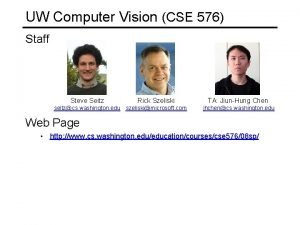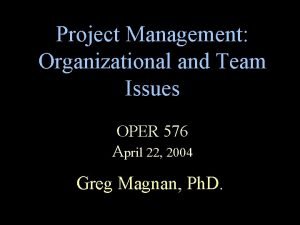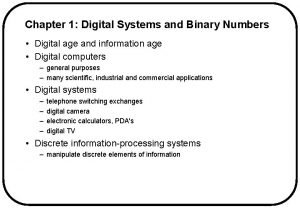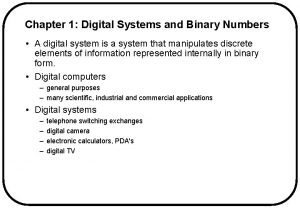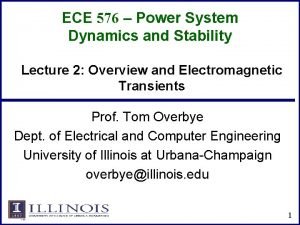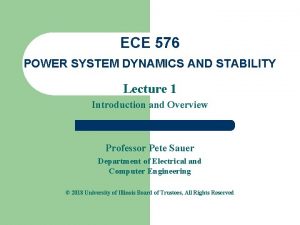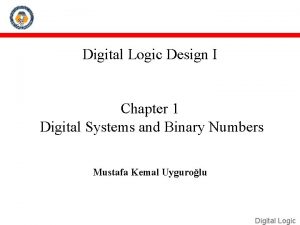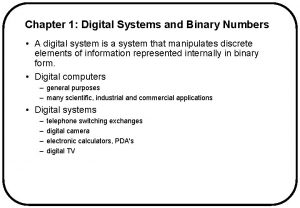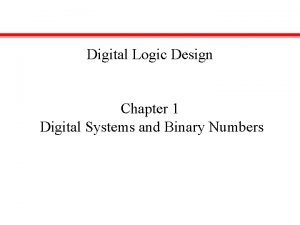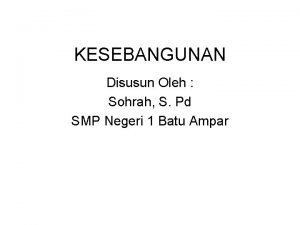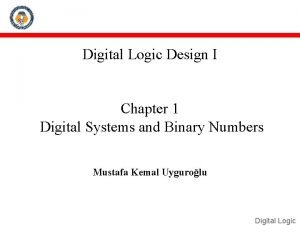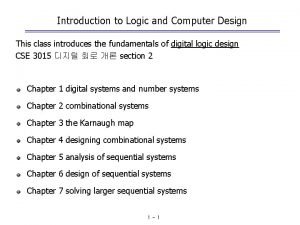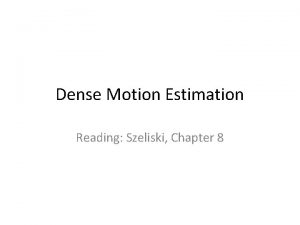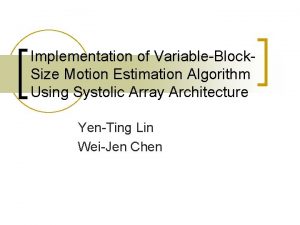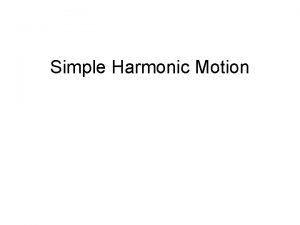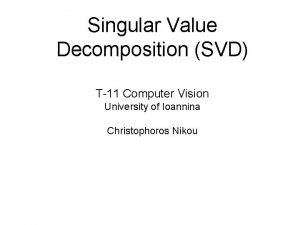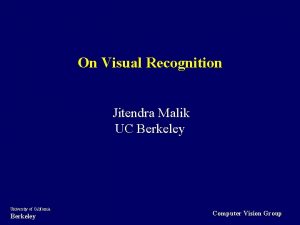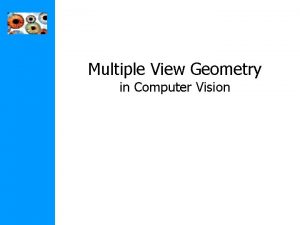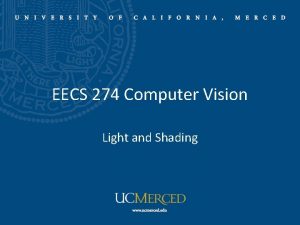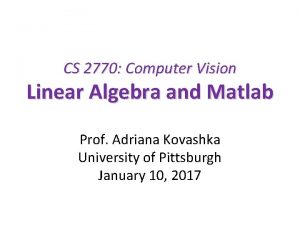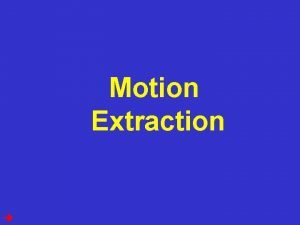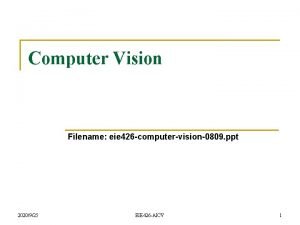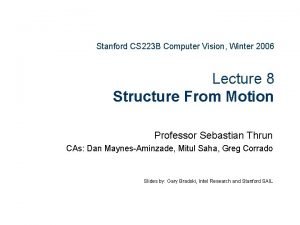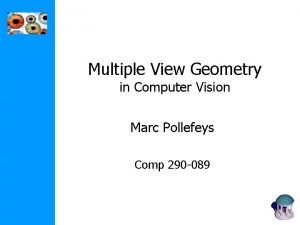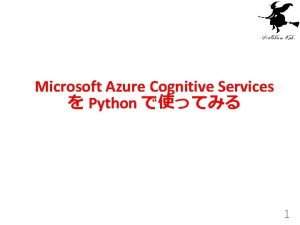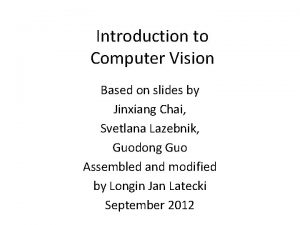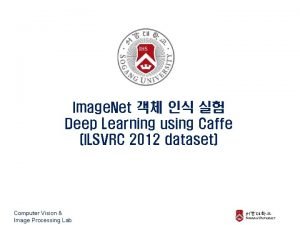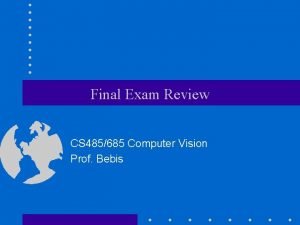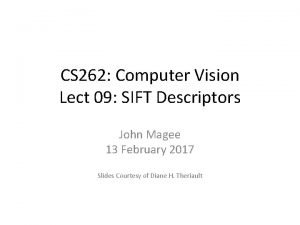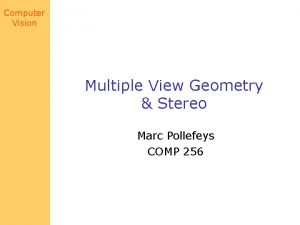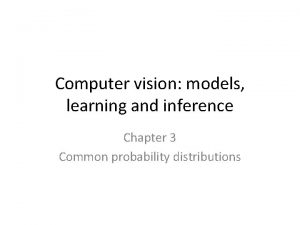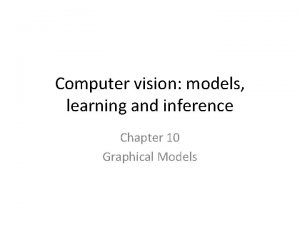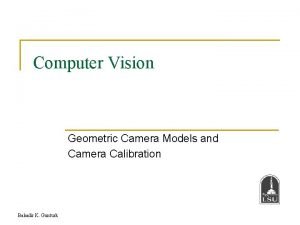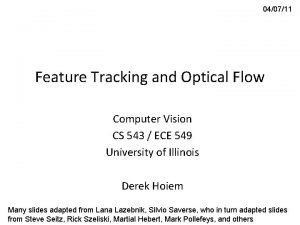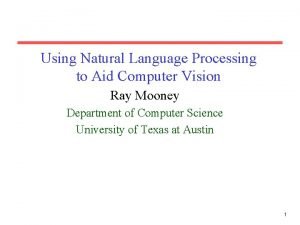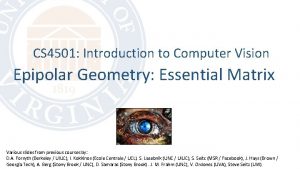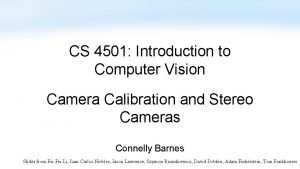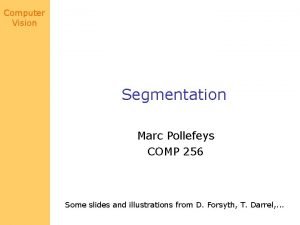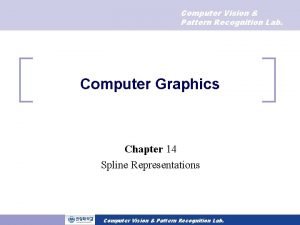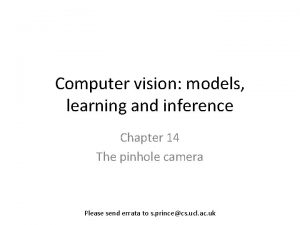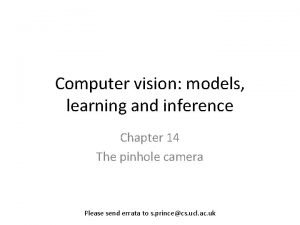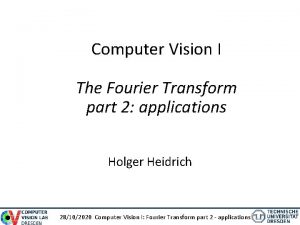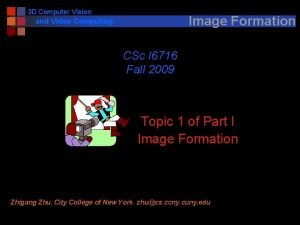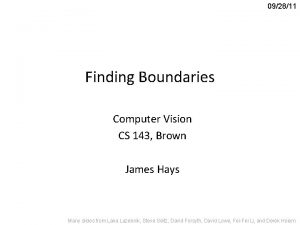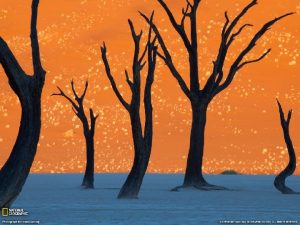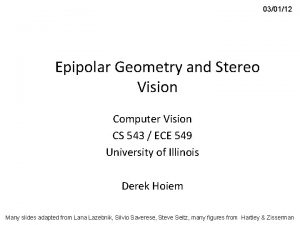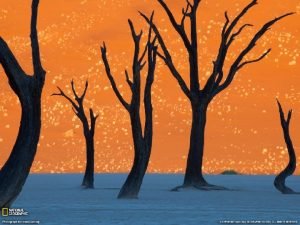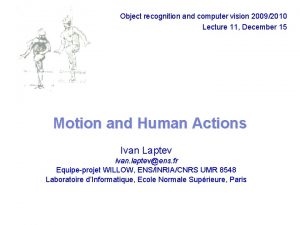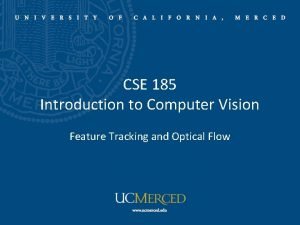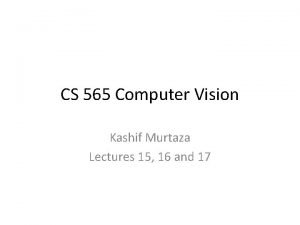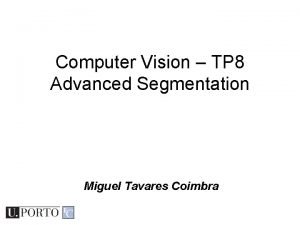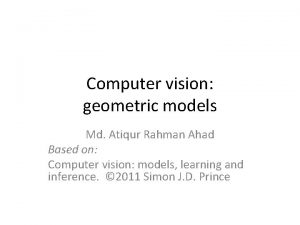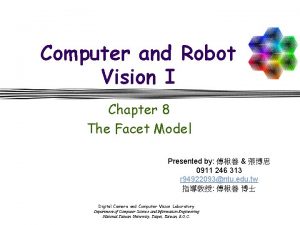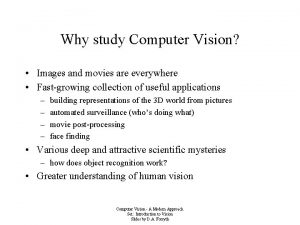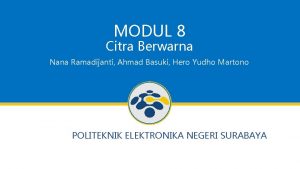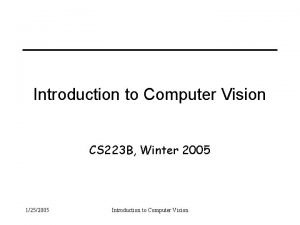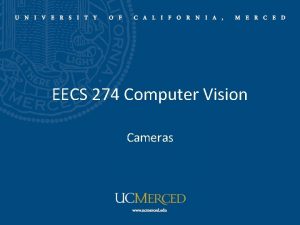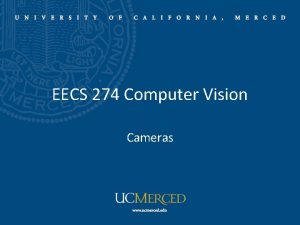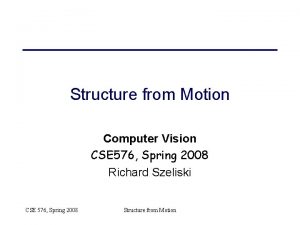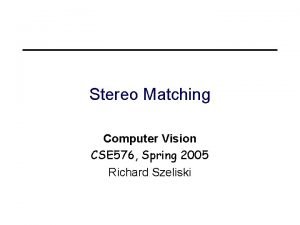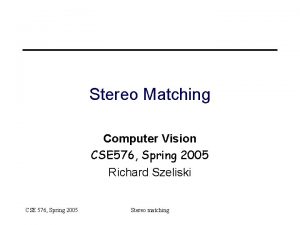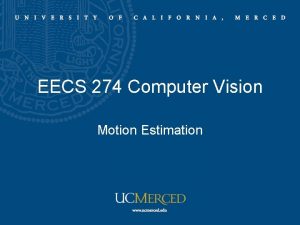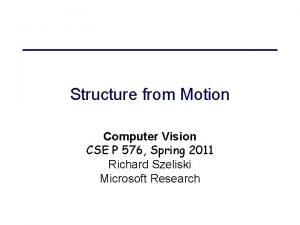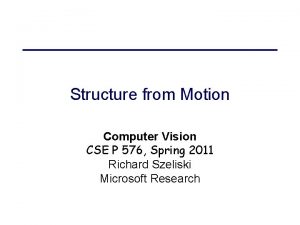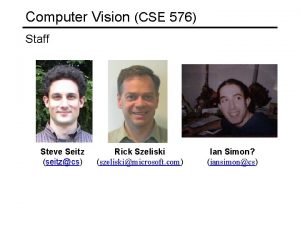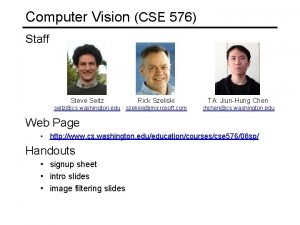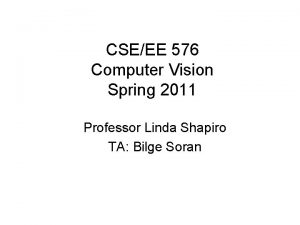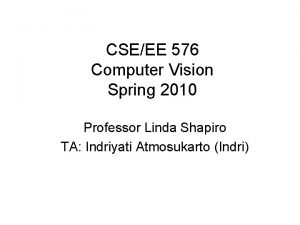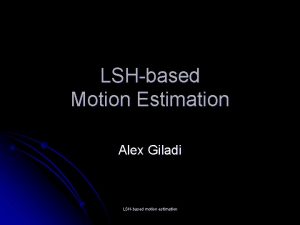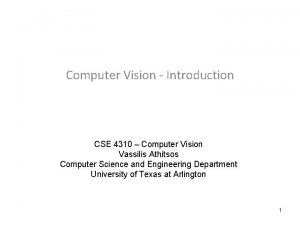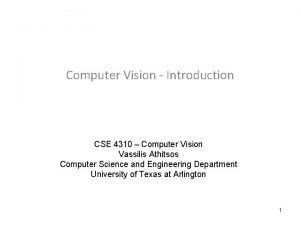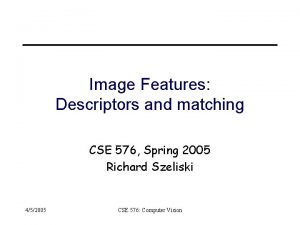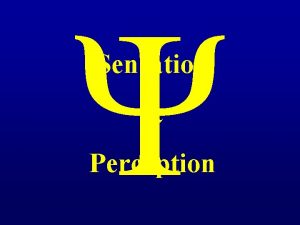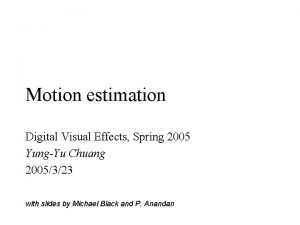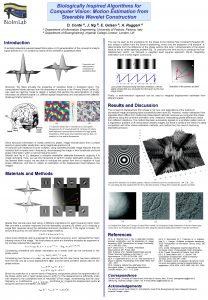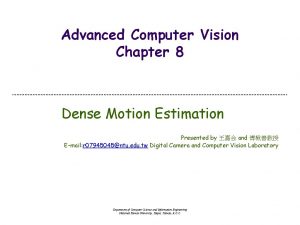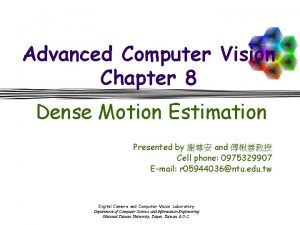Motion estimation Computer Vision CSE 576 Spring 2005









![Patch Translation [Lucas-Kanade] Assume a single velocity for all pixels within an image patch Patch Translation [Lucas-Kanade] Assume a single velocity for all pixels within an image patch](https://slidetodoc.com/presentation_image_h2/0abdf4bb740ab654f62c7e206e6e83cd/image-10.jpg)



























































![What are layers? [Wang & Adelson, 1994] • intensities • alphas • velocities CSE What are layers? [Wang & Adelson, 1994] • intensities • alphas • velocities CSE](https://slidetodoc.com/presentation_image_h2/0abdf4bb740ab654f62c7e206e6e83cd/image-70.jpg)










- Slides: 80

Motion estimation Computer Vision CSE 576, Spring 2005 Richard Szeliski CSE 576, Spring 2008 Motion estimation

Why estimate visual motion? Visual Motion can be annoying • Camera instabilities, jitter • Measure it; remove it (stabilize) Visual Motion indicates dynamics in the scene • Moving objects, behavior • Track objects and analyze trajectories Visual Motion reveals spatial layout • Motion parallax CSE 576, Spring 2008 Motion estimation 2

Today’s lecture Motion estimation • image warping (skip: see handout) • patch-based motion (optic flow) • parametric (global) motion • application: image morphing • advanced: layered motion models CSE 576, Spring 2008 Motion estimation 3

Readings • Szeliski, R. CVAA • Ch. 7. 1, 7. 2, 7. 4 • Bergen et al. Hierarchical model-based motion estimation. ECCV’ 92, pp. 237– 252. • Shi, J. and Tomasi, C. (1994). Good features to track. In CVPR’ 94, pp. 593– 600. • Baker, S. and Matthews, I. (2004). Lucaskanade 20 years on: A unifying framework. IJCV, 56(3), 221– 255. CSE 576, Spring 2008 Motion estimation 4

Patch-based motion estimation CSE 576, Spring 2008 Motion estimation

Classes of Techniques Feature-based methods • Extract visual features (corners, textured areas) and track them • Sparse motion fields, but possibly robust tracking • Suitable especially when image motion is large (10 s of pixels) Direct-methods • Directly recover image motion from spatio-temporal image brightness variations • Global motion parameters directly recovered without an intermediate feature motion calculation • Dense motion fields, but more sensitive to appearance variations • Suitable for video and when image motion is small (< 10 pixels) CSE 576, Spring 2008 Motion estimation 19

Patch matching (revisited) How do we determine correspondences? • block matching or SSD (sum squared differences) CSE 576, Spring 2008 Motion estimation 20

The Brightness Constraint Brightness Constancy Equation: Or, equivalently, minimize : Linearizing (assuming small (u, v)) using Taylor series expansion: CSE 576, Spring 2008 Motion estimation 21

Gradient Constraint (or the Optical Flow Constraint) Minimizing: In general Hence, CSE 576, Spring 2008 Motion estimation 22
![Patch Translation LucasKanade Assume a single velocity for all pixels within an image patch Patch Translation [Lucas-Kanade] Assume a single velocity for all pixels within an image patch](https://slidetodoc.com/presentation_image_h2/0abdf4bb740ab654f62c7e206e6e83cd/image-10.jpg)
Patch Translation [Lucas-Kanade] Assume a single velocity for all pixels within an image patch Minimizing LHS: sum of the 2 x 2 outer product of the gradient vector CSE 576, Spring 2008 Motion estimation 23

Local Patch Analysis How certain are the motion estimates? CSE 576, Spring 2008 Motion estimation 24

The Aperture Problem Let and • Algorithm: At each pixel compute by solving • M is singular if all gradient vectors point in the same direction • e. g. , along an edge • of course, trivially singular if the summation is over a single pixel or there is no texture • i. e. , only normal flow is available (aperture problem) • Corners and textured areas are OK CSE 576, Spring 2008 Motion estimation 25

SSD Surface – Textured area CSE 576, Spring 2008 Motion estimation 26

SSD Surface -- Edge CSE 576, Spring 2008 Motion estimation 27

SSD – homogeneous area CSE 576, Spring 2008 Motion estimation 28

Iterative Refinement Estimate velocity at each pixel using one iteration of Lucas and Kanade estimation Warp one image toward the other using the estimated flow field (easier said than done) Refine estimate by repeating the process CSE 576, Spring 2008 Motion estimation 29

Optical Flow: Iterative Estimation estimate update Initial guess: Estimate: x 0 x (using d for displacement here instead of u) CSE 576, Spring 2008 Motion estimation 30

Optical Flow: Iterative Estimation estimate update Initial guess: Estimate: x 0 CSE 576, Spring 2008 Motion estimation x 31

Optical Flow: Iterative Estimation estimate update Initial guess: Estimate: x 0 CSE 576, Spring 2008 Motion estimation x 32

Optical Flow: Iterative Estimation x 0 CSE 576, Spring 2008 Motion estimation x 33

Optical Flow: Iterative Estimation Some Implementation Issues: • Warping is not easy (ensure that errors in warping are smaller than the estimate refinement) • Warp one image, take derivatives of the other so you don’t need to re-compute the gradient after each iteration. • Often useful to low-pass filter the images before motion estimation (for better derivative estimation, and linear approximations to image intensity) CSE 576, Spring 2008 Motion estimation 34

Optical Flow: Aliasing Temporal aliasing causes ambiguities in optical flow because images can have many pixels with the same intensity. I. e. , how do we know which ‘correspondence’ is correct? actual shift estimated shift nearest match is correct (no aliasing) nearest match is incorrect (aliasing) To overcome aliasing: coarse-to-fine estimation CSE 576, Spring 2008 Motion estimation 35

Coarse-to-Fine Estimation warp refine Jw pixels u=1. 25 + u=2. 5 pixels u=5 pixels image J Pyramid of image J CSE 576, Spring 2008 u=10 pixels Motion estimation image I Pyramid of image I 37

Coarse-to-Fine Estimation J J warp Jw refine I I + pyramid construction J warp pyramid construction I + J warp Jw refine I + CSE 576, Spring 2008 Motion estimation 38

Parametric motion estimation CSE 576, Spring 2008 Motion estimation

Global (parametric) motion models 2 D Models: Affine Quadratic Planar projective transform (Homography) 3 D Models: Instantaneous camera motion models Homography+epipole Plane+Parallax CSE 576, Spring 2008 Motion estimation 40

Motion models Translation Affine Perspective 3 D rotation 2 unknowns 6 unknowns 8 unknowns 3 unknowns CSE 576, Spring 2008 Motion estimation 41

Example: Affine Motion Substituting into the B. C. Equation: Each pixel provides 1 linear constraint in 6 global unknowns Least Square Minimization (over all pixels): CSE 576, Spring 2008 Motion estimation 42

Other 2 D Motion Models Quadratic – instantaneous approximation to planar motion Projective – exact planar motion CSE 576, Spring 2008 Motion estimation 43

3 D Motion Models Instantaneous camera motion: Global parameters: Local Parameter: Homography+Epipole Global parameters: Local Parameter: Residual Planar Parallax Motion Global parameters: Local Parameter: CSE 576, Spring 2008 Motion estimation 44

Patch matching (revisited) How do we determine correspondences? • block matching or SSD (sum squared differences) CSE 576, Spring 2008 Motion estimation 45

Correlation and SSD For larger displacements, do template matching • Define a small area around a pixel as the template • Match the template against each pixel within a search area in next image. • Use a match measure such as correlation, normalized correlation, or sum-of-squares difference • Choose the maximum (or minimum) as the match • Sub-pixel estimate (Lucas-Kanade) CSE 576, Spring 2008 Motion estimation 46

Discrete Search vs. Gradient Based Consider image I translated by The discrete search method simply searches for the best estimate. The gradient method linearizes the intensity function and solves for the estimate CSE 576, Spring 2008 Motion estimation 47

Shi-Tomasi feature tracker 1. Find good features (min eigenvalue of 2 2 Hessian) 2. Use Lucas-Kanade to track with pure translation 3. Use affine registration with first feature patch 4. Terminate tracks whose dissimilarity gets too large 5. Start new tracks when needed CSE 576, Spring 2008 Motion estimation 48

Tracking results CSE 576, Spring 2008 Motion estimation 49

Tracking - dissimilarity CSE 576, Spring 2008 Motion estimation 50

Tracking results CSE 576, Spring 2008 Motion estimation 51

Correlation Window Size Small windows lead to more false matches Large windows are better this way, but… • Neighboring flow vectors will be more correlated (since the template windows have more in common) • Flow resolution also lower (same reason) • More expensive to compute Small windows are good for local search: more detailed and less smooth (noisy? ) Large windows good for global search: less detailed and smoother CSE 576, Spring 2008 Motion estimation 52

Robust Estimation Noise distributions are often non-Gaussian, having much heavier tails. Noise samples from the tails are called outliers. Sources of outliers (multiple motions): • specularities / highlights • jpeg artifacts / interlacing / motion blur • multiple motions (occlusion boundaries, transparency) u 2 velocity space + + u 1 CSE 576, Spring 2008 Motion estimation 53

Robust Estimation Standard Least Squares Estimation allows too much influence for outlying points CSE 576, Spring 2008 Motion estimation 54

Robust Estimation Robust gradient constraint Robust SSD CSE 576, Spring 2008 Motion estimation 55

Robust Estimation Problem: Least-squares estimators penalize deviations between data & model with quadratic error fn (extremely sensitive to outliers) error penalty function influence function Redescending error functions (e. g. , Geman-Mc. Clure) help to reduce the influence of outlying measurements. error penalty function CSE 576, Spring 2008 Motion estimation influence function 56

How well do these techniques work? CSE 576, Spring 2008 Motion estimation

A Database and Evaluation Methodology for Optical Flow Simon Baker, Daniel Scharstein, J. P Lewis, Stefan Roth, Michael Black, and Richard Szeliski ICCV 2007 http: //vision. middlebury. edu/flow/ CSE 576, Spring 2008 Motion estimation

Limitations of Yosemite Only sequence used for quantitative evaluation Image 7 Image 8 Ground-Truth Limitations: Flow • Very simple and synthetic • Small, rigid motion • Minimal motion discontinuities/occlusions CSE 576, Spring 2008 Motion estimation Flow Color Coding 59

Limitations of Yosemite Only sequence used for quantitative evaluation Flow Color Image 7 Image 8 Ground-Truth Coding Current challenges: Flow • Non-rigid motion • Real sensor noise • Complex natural scenes • Motion discontinuities Need more challenging and more realistic benchmarks CSE 576, Spring 2008 Motion estimation 60

Realistic synthetic imagery • Randomly generate scenes with “trees” and “rocks” • Significant occlusions, motion, texture, and blur • Rendered using Mental Ray and “lens shader” plugin CSE 576, Spring 2008 Motion estimation 61

Modified stereo imagery • Recrop and resample ground-truth stereo datasets to have appropriate motion for OF CSE 576, Spring 2008 Motion estimation 62

Dense flow with hidden texture • • Paint scene with textured fluorescent paint Take 2 images: One in visible light, one in UV light Move scene in very small steps using robot Generate ground-truth by tracking the UV images Visible UV Setup CSE 576, Spring 2008 Lights Motion estimation Image Cropped 63

Experimental results Algorithms: • Pyramid LK: Open. CV-based implementation of Lucas-Kanade on a Gaussian pyramid • Black and Anandan: Author’s implementation • Bruhn et al. : Our implementation • Media. Player. TM: Code used for video frame-rate upsampling in Microsoft Media. Player • Zitnick et al. : Author’s implementation CSE 576, Spring 2008 Motion estimation 64

Experimental results CSE 576, Spring 2008 Motion estimation 65

Conclusions • Difficulty: Data substantially more challenging than Yosemite • Diversity: Substantial variation in difficulty across the various datasets • Motion GT vs Interpolation: Best algorithms for one are not the best for the other • Comparison with Stereo: Performance of existing flow algorithms appears weak CSE 576, Spring 2008 Motion estimation 66

Image Morphing CSE 576, Spring 2008 Motion estimation

Image Warping – non-parametric Specify more detailed warp function Examples: • splines • triangles • optical flow (per-pixel motion) CSE 576, Spring 2008 Motion estimation 68

Image Warping – non-parametric Move control points to specify spline warp CSE 576, Spring 2008 Motion estimation 69

Image Morphing How can we in-between two images? 1. Cross-dissolve (all examples from [Gomes et al. ’ 99]) CSE 576, Spring 2008 Motion estimation 70

Image Morphing How can we in-between two images? 2. Warp then cross-dissolve = morph CSE 576, Spring 2008 Motion estimation 71

Warp specification How can we specify the warp? 1. Specify corresponding points • interpolate to a complete warping function • Nielson, Scattered Data Modeling, IEEE CG&A’ 93] CSE 576, Spring 2008 Motion estimation 72

Warp specification How can we specify the warp? 2. Specify corresponding vectors • interpolate to a complete warping function CSE 576, Spring 2008 Motion estimation 73

Warp specification How can we specify the warp? 2. Specify corresponding vectors • interpolate [Beier & Neely, SIGGRAPH’ 92] CSE 576, Spring 2008 Motion estimation 74

Warp specification How can we specify the warp? 3. Specify corresponding spline control points • interpolate to a complete warping function CSE 576, Spring 2008 Motion estimation 75

Final Morph Result CSE 576, Spring 2008 Motion estimation 76

Layered Scene Representations CSE 576, Spring 2008 Motion estimation

Motion representations How can we describe this scene? CSE 576, Spring 2008 Motion estimation 78

Block-based motion prediction Break image up into square blocks Estimate translation for each block Use this to predict next frame, code difference (MPEG-2) CSE 576, Spring 2008 Motion estimation 79

Layered motion Break image sequence up into “layers”: = Describe each layer’s motion CSE 576, Spring 2008 Motion estimation 80

Layered motion Advantages: • can represent occlusions / disocclusions • each layer’s motion can be smooth • video segmentation for semantic processing Difficulties: • how do we determine the correct number? • how do we assign pixels? • how do we model the motion? CSE 576, Spring 2008 Motion estimation 81

Layers for video summarization CSE 576, Spring 2008 Motion estimation 82

Background modeling (MPEG-4) Convert masked images into a background sprite for layered video coding + + + = CSE 576, Spring 2008 Motion estimation 83
![What are layers Wang Adelson 1994 intensities alphas velocities CSE What are layers? [Wang & Adelson, 1994] • intensities • alphas • velocities CSE](https://slidetodoc.com/presentation_image_h2/0abdf4bb740ab654f62c7e206e6e83cd/image-70.jpg)
What are layers? [Wang & Adelson, 1994] • intensities • alphas • velocities CSE 576, Spring 2008 Motion estimation 84

How do we form them? CSE 576, Spring 2008 Motion estimation 87

How do we estimate the layers? 1. 2. 3. 4. 5. compute coarse-to-fine flow estimate affine motion in blocks (regression) cluster with k-means assign pixels to best fitting affine region re-estimate affine motions in each region… CSE 576, Spring 2008 Motion estimation 88

Layer synthesis For each layer: • stabilize the sequence with the affine motion • compute median value at each pixel Determine occlusion relationships CSE 576, Spring 2008 Motion estimation 89

Results CSE 576, Spring 2008 Motion estimation 90

Bibliography L. Williams. Pyramidal parametrics. Computer Graphics, 17(3): 1 --11, July 1983. L. G. Brown. A survey of image registration techniques. Computing Surveys, 24(4): 325 --376, December 1992. C. D. Kuglin and D. C. Hines. The phase correlation image alignment method. In IEEE 1975 Conference on Cybernetics and Society, pages 163 --165, New York, September 1975. J. Gomes, L. Darsa, B. Costa, and L. Velho. Warping and Morphing of Graphical Objects. Morgan Kaufmann, 1999. T. Beier and S. Neely. Feature-based image metamorphosis. Computer Graphics (SIGGRAPH'92), 26(2): 35 --42, July 1992. CSE 576, Spring 2008 Motion estimation 91

Bibliography J. R. Bergen, P. Anandan, K. J. Hanna, and R. Hingorani. Hierarchical model-based motion estimation. In ECCV’ 92, pp. 237– 252, Italy, May 1992. M. J. Black and P. Anandan. The robust estimation of multiple motions: Parametric and piecewise-smooth flow fields. Comp. Vis. Image Understanding, 63(1): 75– 104, 1996. Shi, J. and Tomasi, C. (1994). Good features to track. In CVPR’ 94, pages 593– 600, IEEE Computer Society, Seattle. Baker, S. and Matthews, I. (2004). Lucas-kanade 20 years on: A unifying framework: Part 1: The quantity approximated, the warp update rule, and the gradient descent approximation. IJCV, 56(3), 221– 255. CSE 576, Spring 2008 Motion estimation 92

Bibliography H. S. Sawhney and S. Ayer. Compact representation of videos through dominant multiple motion estimation. IEEE Trans. Patt. Anal. Mach. Intel. , 18(8): 814– 830, Aug. 1996. Y. Weiss. Smoothness in layers: Motion segmentation using nonparametric mixture estimation. In CVPR’ 97, pp. 520– 526, June 1997. J. Y. A. Wang and E. H. Adelson. Representing moving images with layers. IEEE Transactions on Image Processing, 3(5): 625 --638, September 1994. CSE 576, Spring 2008 Motion estimation 93

Bibliography Y. Weiss and E. H. Adelson. A unified mixture framework for motion segmentation: Incorporating spatial coherence and estimating the number of models. In IEEE Computer Society Conference on Computer Vision and Pattern Recognition (CVPR'96), pages 321 --326, San Francisco, California, June 1996. Y. Weiss. Smoothness in layers: Motion segmentation using nonparametric mixture estimation. In IEEE Computer Society Conference on Computer Vision and Pattern Recognition (CVPR'97), pages 520 --526, San Juan, Puerto Rico, June 1997. P. R. Hsu, P. Anandan, and S. Peleg. Accurate computation of optical flow by using layered motion representations. In Twelfth International Conference on Pattern Recognition (ICPR'94), pages 743 --746, Jerusalem, Israel, October 1994. IEEE Computer Society Press CSE 576, Spring 2008 Motion estimation 94

Bibliography T. Darrell and A. Pentland. Cooperative robust estimation using layers of support. IEEE Transactions on Pattern Analysis and Machine Intelligence, 17(5): 474 --487, May 1995. S. X. Ju, M. J. Black, and A. D. Jepson. Skin and bones: Multi-layer, locally affine, optical flow and regularization with transparency. In IEEE Computer Society Conference on Computer Vision and Pattern Recognition (CVPR'96), pages 307 --314, San Francisco, California, June 1996. M. Irani, B. Rousso, and S. Peleg. Computing occluding and transparent motions. International Journal of Computer Vision, 12(1): 5 --16, January 1994. H. S. Sawhney and S. Ayer. Compact representation of videos through dominant multiple motion estimation. IEEE Transactions on Pattern Analysis and Machine Intelligence, 18(8): 814 --830, August 1996. M. -C. Lee et al. A layered video object coding system using sprite and affine motion model. IEEE Transactions on Circuits and Systems for Video Technology, 7(1): 130 --145, February 1997. CSE 576, Spring 2008 Motion estimation 95

Bibliography S. Baker, R. Szeliski, and P. Anandan. A layered approach to stereo reconstruction. In IEEE CVPR'98, pages 434 --441, Santa Barbara, June 1998. R. Szeliski, S. Avidan, and P. Anandan. Layer extraction from multiple images containing reflections and transparency. In IEEE CVPR'2000, volume 1, pages 246 --253, Hilton Head Island, June 2000. J. Shade, S. Gortler, L. -W. He, and R. Szeliski. Layered depth images. In Computer Graphics (SIGGRAPH'98) Proceedings, pages 231 --242, Orlando, July 1998. ACM SIGGRAPH. S. Laveau and O. D. Faugeras. 3 -d scene representation as a collection of images. In Twelfth International Conference on Pattern Recognition (ICPR'94), volume A, pages 689 --691, Jerusalem, Israel, October 1994. IEEE Computer Society Press. P. H. S. Torr, R. Szeliski, and P. Anandan. An integrated Bayesian approach to layer extraction from image sequences. In Seventh ICCV'98, pages 983 --990, Kerkyra, Greece, September 1999. CSE 576, Spring 2008 Motion estimation 96
 Cse576
Cse576 Structured light
Structured light Factors of 576
Factors of 576 Bcd addition of 184 and 576
Bcd addition of 184 and 576 Rh nomenclature
Rh nomenclature Binary code example
Binary code example Ece 576
Ece 576 Ece 576
Ece 576 Bcd addition of 184 and 576
Bcd addition of 184 and 576 Bcd addition of 184 and 576
Bcd addition of 184 and 576 Bcd addition of 184 and 576
Bcd addition of 184 and 576 Diketahui pq // ab rq // ac bac = 65°
Diketahui pq // ab rq // ac bac = 65° Bcd addition of 184 and 576
Bcd addition of 184 and 576 Bcd addition of 184 and 576
Bcd addition of 184 and 576 Spring summer fall winter and spring cast
Spring summer fall winter and spring cast Winter fall summer
Winter fall summer Dense motion estimation
Dense motion estimation Motion estimation algorithms
Motion estimation algorithms Shm of a spring
Shm of a spring Elmore vision motion picture soundtracks love yourself
Elmore vision motion picture soundtracks love yourself Type of range of motion
Type of range of motion Simple harmonic motion
Simple harmonic motion An object in motion stays in motion
An object in motion stays in motion Chapter 2 motion section 1 describing motion answer key
Chapter 2 motion section 1 describing motion answer key Measuring motion
Measuring motion Section 1 describing motion
Section 1 describing motion Describing motion section 1 answer key
Describing motion section 1 answer key Motion section 1 describing motion
Motion section 1 describing motion 16-385 cmu
16-385 cmu Kalman filter computer vision
Kalman filter computer vision Svd example
Svd example Berkeley computer vision
Berkeley computer vision Multiple view geometry in computer vision
Multiple view geometry in computer vision Face detection viola jones
Face detection viola jones Radiometry in computer vision
Radiometry in computer vision Linear algebra for computer vision
Linear algebra for computer vision Impoverished motion examples
Impoverished motion examples Computer vision
Computer vision Watershed segmentation
Watershed segmentation Computer vision stanford
Computer vision stanford Multiple view geometry in computer vision
Multiple view geometry in computer vision Python cognitive services
Python cognitive services Mathematical foundations of computer graphics and vision
Mathematical foundations of computer graphics and vision Computer vision slides
Computer vision slides Ilsvrc-2012
Ilsvrc-2012 Computer vision final exam
Computer vision final exam Sift computer vision
Sift computer vision Multiple view geometry in computer vision
Multiple view geometry in computer vision Computer vision: models, learning, and inference
Computer vision: models, learning, and inference Computer vision models learning and inference pdf
Computer vision models learning and inference pdf Coordinate rotation matrix
Coordinate rotation matrix Computer
Computer Computer vision vs nlp
Computer vision vs nlp Epipolar geometry computer vision
Epipolar geometry computer vision Computer vision camera calibration
Computer vision camera calibration Computer vision
Computer vision Decomposition
Decomposition Computer vision
Computer vision Computer vision
Computer vision Computer vision
Computer vision Computer vision
Computer vision Fourier transform in computer vision
Fourier transform in computer vision Image formation computer vision
Image formation computer vision Computer vision brown
Computer vision brown Computer vision brown
Computer vision brown Epipolar geometry computer vision
Epipolar geometry computer vision Computer vision brown
Computer vision brown Szeliski computer vision
Szeliski computer vision Computer vision
Computer vision Aperture problem
Aperture problem Murtaza computer vision
Murtaza computer vision Computer vision
Computer vision Computer vision
Computer vision Computer and robot vision
Computer and robot vision Computer vision pipeline
Computer vision pipeline Why study computer vision
Why study computer vision Hyeonseob
Hyeonseob Computer vision
Computer vision Computer vision
Computer vision Camera models in computer vision
Camera models in computer vision Camera models in computer vision
Camera models in computer vision
